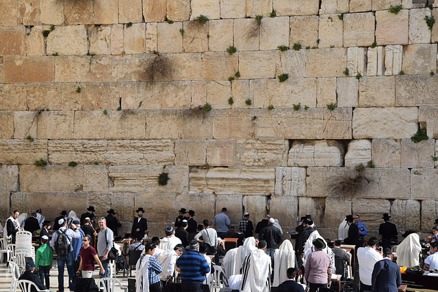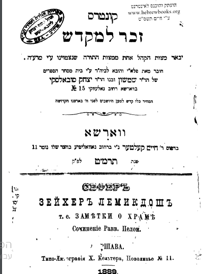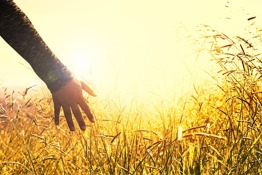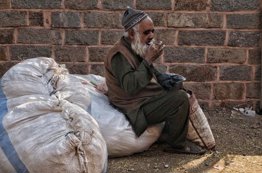Zecher LeHakhel

When did the zecher lehakel ceremonies start?
The penultimate mitzvah listed in the Torah is hakhel (Devarim 31:1-13):
וַיְצַו מֹשֶׁה אוֹתָם לֵאמֹר: מִקֵּץ שֶׁבַע שָׁנִים בְּמֹעֵד שְׁנַת הַשְּׁמִטָּה בְּחַג הַסֻּכּוֹת. בְּבוֹא כָל יִשְׂרָאֵל לֵרָאוֹת אֶת פְּנֵי ה' אֱלוֹקֶיךָ בַּמָּקוֹם אֲשֶׁר יִבְחָר, תִּקְרָא אֶת הַתּוֹרָה הַזֹּאת נֶגֶד כָּל יִשְׂרָאֵל בְּאָזְנֵיהֶם. הַקְהֵל אֶת הָעָם הָאֲנָשִׁים וְהַנָּשִׁים וְהַטַּף וְגֵרְךָ אֲשֶׁר בִּשְׁעָרֶיךָ, לְמַעַן יִשְׁמְעוּ וּלְמַעַן יִלְמְדוּ, וְיָרְאוּ אֶת ה' אֱלוֹקֵיכֶם וְשָׁמְרוּ לַעֲשׂוֹת אֶת כָּל דִּבְרֵי הַתּוֹרָה הַזֹּאת. וּבְנֵיהֶם אֲשֶׁר לֹא יָדְעוּ יִשְׁמְעוּ וְלָמְדוּ לְיִרְאָה אֶת ה' אֱלוֹקֵיכֶם כָּל הַיָּמִים אֲשֶׁר אַתֶּם חַיִּים עַל הָאֲדָמָה אֲשֶׁר אַתֶּם עֹבְרִים אֶת הַיַּרְדֵּן שָׁמָּה לְרִשְׁתָּהּ
And Moses instructed them as follows: Every seventh year, the year set for remission, at the Feast of Booths, when all Israel comes to appear before your G-d in the place that [G-d] will choose, you shall read this Teaching aloud in the presence of all Israel. Gather the people—men, women, children and the strangers in your communities—that they may hear and so learn to revere your G-d and to observe faithfully every word of this Teaching. Their children, too, who have not had the experience, shall hear and learn to revere your G-d as long as they live in the land that you are about to cross the Jordan to possess.
Sefer HaChinuch (Mitzvah 612) cites the rationale for the mitzvah:
מִשָּׁרְשֵׁי הַמִּצְוָה. לְפִי שֶׁכָּל עִקָּרָן שֶׁל עַם יִשְׂרָאֵל הִיא הַתּוֹרָה, וּבָהּ יִפָּרְדוּ מִכָּל אֻמָּה וְלָשׁוֹן לִהְיוֹת זוֹכִין לְחַיֵּי עַד, תַּעֲנוּג נִצְחִי שֶׁאֵין לְמַעְלָה הֵימֶנּוּ בַּנִּבְרָאִים. עַל כֵּן בִּהְיוֹת כָּל עִקָּרָן בָּהּ, רָאוּי שֶׁיִּקָּהֲלוּ הַכֹּל יַחַד בִּזְמַן אֶחָד מִן הַזְּמַנִּים לִשְׁמֹעַ דְּבָרֶיהָ, וְלִהְיוֹת הַקּוֹל יוֹצֵא בְּתוֹךְ כָּל הָעָם, אֲנָשִׁים וְנָשִׁים וָטָף, לֵאמֹר: מָה הַקִּבּוּץ הָרַב הַזֶּה שֶׁנִּתְקַבַּצְנוּ יַחַד כֻּלָּנוּ? וְתִהְיֶה הַתְּשׁוּבָה: לִשְׁמוֹעַ דִּבְרֵי הַתּוֹרָה שֶׁהִיא כָּל עִקָּרֵנוּ וְהוֹדֵנוּ וְתִפְאַרְתֵּנוּ. וְיָבוֹאוּ מִתּוֹךְ כָּךְ לְסַפֵּר בְּגֹדֶל שִׁבְחָהּ וְהוֹד עֶרְכָּהּ וְיַכְנִיסוּ הַכֹּל בְּלִבָּם חֲשָׁקָהּ. וְעִם הַחֵשֶׁק בָּהּ יִלְמְדוּ לְדַעַת אֶת הַשֵּׁם וְיִזְכּוּ לְטוֹבָה, וְיִשְׂמַח הַשֵּׁם בְּמַעֲשָׂיו. וּכְעִנְיָן שֶׁכָּתוּב בְּפֵרוּשׁ בְּזֹאת הַמִּצְוָה, וּלְמַעַן יִלְמְדוּ וְיָרְאוּ אֶת ד
It is from the roots of the commandment [that it is] because the entire essence of the people of Israel is the Torah; and through it are they separated from every nation and language, to be meritorious for life of the forever - eternal pleasure that is not surpassed by anything among the creatures. Therefore, since their entire essence is in it, it is fitting that everyone should gather together at one point in time to hear its words, and for the voice to go out amongst the whole nation - men, women, and infants - to say, "What is the great gathering, that we have all been gathered together?" And the answer would be, "To hear the words of the Torah, which is our entire essence and glory and splendor." And they will come from this to tell of the great praise and the splendor of its value; and its yearning will enter all of their hearts. And with this yearning for it, they will learn to know G-d and merit good, and 'G-d will be happy with His creations' - like the matter that is written in explanation of this commandment and in order that they will learn and fear the L-rd.
Similarly, Rambam (Hilchot Chagigah 3:6) states:
שֶׁלֹּא קָבְעָה הַכָּתוּב אֶלָּא לְחַזֵּק דַּת הָאֱמֶת, וְיֵרָאֶה עַצְמוֹ כְּאִלּוּ עַתָּה נִצְטַוָּה בָּהּ וּמִפִּי הַגְּבוּרָה שׁוֹמְעָהּ, שֶׁהַמֶּלֶךְ שָׁלִיחַ הוּא לְהַשְׁמִיעַ דִּבְרֵי הָאֵ-ל
"For Scripture established it solely to strengthen the true faith. He should see himself as if he was just now commanded regarding the Torah and heard it from the Almighty. For the king is an agent to make known the word of G-d."
There is great importance to assembling the entire Jewish People together. It serves to reaffirm the covenant at Mt. Sinai in each and every generation when the nation assembles at the Beit Hamikdash.
Despite the fact that it is a time-bound mitzvah, women are nevertheless obligated in hakhel since it is important that everyone attend: men, women, and children. It is specifically the king who reads from the Torah, not the prophet, high priest or head of the Sanhedrin.
While there is no explicit account of hakhel the tanach from either the First or Second Temple, the Sages describe hahkel in the times of Rechava'am, Agrippa I, and an additional ceremony attended by Rabbi Tarfon.
Zecher Lehakhel – Commemoration of Hakhel
Following destruction of the Second Temple, several enactments were instituted in commemoration of the Temple, such as waving the arba minim throughout the seven days of Sukkot not only in the Temple (Mishnah Sukkah 3:12). The Gemara states (Sukkah 41a) that the Sages learn from the verse "צִיּוֹן הִיא דֹּרֵשׁ אֵין לָהּ" "she is Zion, there is none that seeks her" (Yermiyahu 30:17) that one should "seek her" and commemoration of the Temple (zecher lamikdash)
There are additional enactments (takanot) mentioned in the Gemara and by Rishonim in commemoration of the Temple: The Hillel sandwich on Pesach (Pesachim 115b; eating matzah with marror together on Seder night, zecher lemikdash keHillel); sefirat ha'omer (Menachot 66a)` circling the bimah holding the arba minim (in commemoration of circling the mizbe'ach seven times; Rambam Lulav 7:23); taking aravot and hitting the ground on Hoshanah Rabbah (ibid., 7:22); not eating dessert after eating the afikoman (commemorating the prohibition to eat after partaking of the korban Pesach; Ra'avad 56 – עבדינן זכר למקדש, "we do this in commemoration of the Temple); to avoid looking at the kohanim when they recite the priestly blessing (Mishnah Berurah 128:89), reciting pitom haketoret, among others.
The First Calling for a Commemoration of Hakhel
In Elul of the shemitah year 5649 (1889), a pamphlet (kuntres) was published in Warsaw anonymously, called Kuntres Zecher LaMikdash, whose secondary title stated "[This pamphlet] will expound on the mitzvah of hakhel, one of the Torah's mitzvot commanded by Moshe our teacher of blessed memory."
The booklet received approbations of three famous rabbis: Rabbi Yosef Dov Bear HaLevi (Beit HaLevy), Rabbi Shmuel Mohilever, and Rabbi Eliahu David Rabinowitz Teomim (Aderet) of Ponevezh, the latter of whom also wrote several notes on the booklet. One-thousand copies of the booklet were printed and sent to many rabbis. The booklet includes five chapters that detail different aspects of the mitzvah (who is obligated, what is done during the ceremony, and when, where, and how it is performed). In the introduction, the author insists that it is proper to commemorate hakhel today, just as we commemorate the Temple in other ways. Fourteen years later, on Sukkot 5664 (1904), a nearly identical booklet was published in Jerusalem. Who is the anonymous rabbi?

Today we know that the author of the original booklet was the Aderet, who wrote it when he was the rabbi of Ponevezh, Lithuania in 5649 (1889). He later made Aliyah in 5661 (1901) and passed away three years later (5664, 1904). It turns out that he wrote the approbation and notes for his own work.
Shemitah from 5649-5706 (1889-1945)
Rabbi Kook was the Aderet's son-in-law. While Rabbi Kook dealt extensively with the topic of shemitah, he was not at all involved with zecher lehakhel. On Sukkot 5671, Rabbi Kook was already in the Land of Israel, but he channeled his energy towards heter mechirah, which he formalized, and support for farmers. It is possible that he did not have the time for zecher lehakhel. Furthermore, he may have realized that there would be resistance to the notion and wanted to avoid any unnecessary conflicts. In 5678, Rabbi Kook was stuck abroad during World War I. In 5685 he participated in a delegation of Rabbis in the United States. The following shemitah, 5691, he was in the Land of Israel but did not raise the issue. Rabbi Herzog wrote: "And after my pious, brilliant predecessor (may his merit protect us) returned from abroad to the Land of Israel, then under British rule, he only experienced two shemitot and the idea did not have time to mature."
In 5699, right before WWII, Rabbi Ben Zion Uziel wrote on the topic, but nothing came out of it. Perhaps this is because he was not yet officially the Chief Rabbi.
The first zecher lehakhel event, Sukkot 5706 - 1945
Following the Holocaust, there was a strong desire to unite the survivors who recently immigrated to the Land of Israel under great duress with the veteran local population. World War II was over September 2, 1945, 24 Elul 5705, right at the end of a shemitah year.
Rabbi Yaakov Moshe Charlop wrote (Kovetz Hakhel, Jerusalem: Mossad HaRav Kook 5733?):
בְּיִחוּד רְאוּיָה הִיא הַהִתְעוֹרְרוּת לְמִצְוַת הַקְהֵל בְּעֵת כָּזֹאת, אֲשֶׁר הִשְׁבַּרְנוּ וְשָׁתִינוּ מִכּוֹס הַתַּרְעֵלָה כִּי בָּאָה עָלֵינוּ חֶרֶב נֹקֶמֶת נְקַם בְּרִית, קָמוּ עָלֵינוּ עָרִיצִים וּפְרִיצִי חַיּוֹת לָקַחַת אֶת נַפְשֵׁנוּ וּלְהַשְׁמִיד אֶת זְכָרָנוּ. הִנֵּה לְעֻמַּת זֶה אָנוּ צְרִיכִים לְהוֹצִיא אֶת חַרְבֵּנוּ מִתַּעְרָהּ, הִיא הַחֶרֶב פִּיפִיּוֹת שֶׁרַק עַל יָדָהּ הִנְנוּ עוֹשִׂים נְקָמָה בַּגּוֹיִים
"It is especially fitting to revive the mitzvah of hakhel at this time, after we have been broken and have drained the cup of staggering when the vengeful sword has been raised against us to wreak vengeance for the covenant, and tyrants and wild beasts have risen upon us to take our lives and blot out our remembrance. And now, in response, we must unsheathe our double-edged sword, and only with it can we take vengeance on the Gentiles."
That is, our double-edged sword is the Torah and unity, which can counter the sword of the Gentiles.
From Tel Aviv a special train went out to Jerusalem early in the morning and everyone gathered at the Yeshurun synagogue.
Rabbi Meir Bar Ilan, one of the heads of Mizrachi, opened the event. Then the Ashkenazi chief rabbi, Rabbi Herzog, read the verses read by the king from a chumash. Afterwards, the masses walked to the Western Wall and recited Tehillim (apparently the whole ceremony was not held at the Western Wall for lack of room!).
A pamphlet "קובץ מיוחד למצוות הקהל ובירור הלכותיה" "A special anthology on the mitzvot of Hahkel and an examination of its laws," was then published by Mossad HaRav Kook (Jerusalem). The editor was Rabbi Binyamin Rabinowitz Teomim, grandson of the Aderet's twin brother. The anthology features the Aderet's original booklet noting his name, alongside articles by Rabbi Chaim Berlin (son of the Netziv), Rabbi Herzog, Rabbi Charlop, Rabbi Shlomo David Kehana (rabbi of the Old City), and Rabbi Yosef HaLevy (av beit din in Tel Aviv), Rabbi Shlomo Yosef Zevin, and Rabbi Tzvi Yehuda Kook. The event was organized by the Cultural Center of HaPoel HaMizrachi. The moving force behind the event was (Rabbi) Dr. Shmuel Zanvil Kahane, son of Rabbi Shlomo David Kahane. After the establishment of the State of Israel, he continued to organize the event in the capacity of his job as manager of Misrad HaDatot (Bureau of Religious Affairs) and later as Director General of the Ministry of Religious Affairs.
Sukkot 5713 - 1953
The first ceremony after the establishment of the State of Israel. Invitations were sent by Israel's chief rabbis, Rabbi Herzog and Rabbi Uziel, to rabbis around the world. A booklet entitled Talpiyot, published by Yeshiva University that year, included an article by Rabbi Prof. Samuel Kalman Mirsky on the topic.
On 17 Tishrei 5713, the second day of chol hamoed Sukkot, the event took place at the HaPoel stadium in Katamon. A train went there from Tel Aviv to Jerusalem. It was pushed off by a day to allow those who observe a second day of yom tov to participate. The reason it was at the stadium was that after the War of Independence, the Western Wall was under Jordanian rule.
Sukkot 5720 - 1960
The event took place at Mt. Zion with the participation of approximately 10,000 people. Chief Sephardic Rabbi Yitzchak Nissim blessed the participants.
Sukkot 5727 - 1967
Chief Rabbis Unterman and Nissim participated in the event, held on Sunday, the third day of chol hamo'ed (18 Tishrei), again on Mt. Zion, with approximately 20,000 people in attendance. This was six months before the Six Day War.
Sukkot 5734 - 1974
The Yom Kippur War has just broken out, so the event was cancelled.
Sukkot 5741 - 1981
The event took place on Sunday, the third day of chol hamo'ed (18 Tishrei) at the Western Wall. This was the first time the event took place at the Western Wall.
The President of the State Yitzhak Navon greeted the masses, the Rabbi of the Western Wall Rav Yehuda Meir Getz said a prayer, and the Chief Rabbis Ovadia Yosef and Shlomo Goren spoke.
Sukkot 5748 - 1988
The most significant zecher lehakhel event thus far. It took place 19 Tishrei, the fourth day of chol hamo'ed at 8 PM. The Western Wall plaza was packed. It was also marked Israel's 40-year anniversary, and there was extensive publicity. There were video screens and the event was broadcast on Channel 2 and throughout the world.
Minister of Religious Affairs, Zevulun Hammer greeted the participants, President Haim Herzog (son of Rabbi Herzog, who participated in the very first zecher lehakhel event in 5706) read from the first Torah scroll. This was the first time that Israel's president read from the Torah (and not only greeted the participants).
Prof. Hillel Weiss wrote a poem entitled רְשׁוּת לִכְבוֹד נְשִׂיא מְדִינַת יִשְׂרָאֵל:
| Arise, arise and read this Torah scroll Since our Temple was destroyed no president has read it at all Be the first president to read and commemorate hakhel So that Israel will hear and the whole world as well |
עֲמֹד עָמוֹד וְקָרָא בְּזֹאת הַתּוֹרָה מֵאָז חָרַב בֵּיתֵנוּ נָשִׂיא לֹא קָרְאָה הֱיֵה חָתָן נְשִׂיא רִאשׁוֹן לְקוֹרְאֵי זֶכֶר לְהַקְהֵל לְמַעַן יִשְׁמַע יִשְׂרָאֵל אַף תֵּבֵל |
The second scroll was read by Ashkenazi Chief Rabbi Avraham Kahane Shapira. The third scroll was read by the Sephardi Chief Rabbi Mordechai Eliahu.
A prayer was said, based on the blessings that were said by the king after the end of the Torah reading, a prayer for the wellbeing of the world, on behalf of the IDF, and for the wellbeing of the State of Israel.
Dignitaries at the platform of honor included PM Yitzchak Shamir, President of the Supreme Court Meir Shamgar, and others. The Holy Ark was opened by the IDF's Chief Rabbi Gad Navon. The Torah scrolls were taken out by Rabbi Meir Yehuda Getz, Rabbi of the Western Wall.
Opposition
Chazon Ish: In 5706 (1945), An Anthology on the Mitzvah of Hakhel was published before the event. The Chazon Ish wrote on the front of the booklet "It is forbidden to do so." It seems that he was concerned about new enactments. Rabbi Yitzchak Zev Soloveitchik also voiced his opposition.
Rabbi Elazar Menachem Mann Shach, Rosh Yeshiva of Ponevezh, Benei Berak, put out a letter on 7 Tishrei 5748 (1988):
כַּאֲשֶׁר נִתְפַּרְסֵם בָּרַבִּים בְּעִתּוֹנִים וּבַמִּכְתָּבִים פְּנִיָּה לְכָל עַם יִשְׂרָאֵל בְּכָל מָקוֹם שֶׁהֵם, שֶׁיֵּעָרֵךְ עַל יַד הַכֹּתֶל הַמַּעֲרָבִי כִּנּוּס גָּדוֹל, אֲשֶׁר בְּשֵׁם "הַקְהֵל" יִקְרָא, כְּדֻגְמַת מִצְוַת הַקְהֵל הַמְּצֻוֶּה עָלֵינוּ בְּתוֹרָתֵנוּ הַקְּדֻשָּׁה בְּמוֹצָאֵי שְׁנַת הַשְּׁמִטָּה בְּחַג הַסֻּכּוֹת, לְהִתְאַסֵּף אֲנָשִׁים נָשִׁים וָטַף וְהַמֶּלֶךְ יִקָּרֵא, לְמַעַן יִשְׁמְעוּן וְכוּ', וְזֶה הָיָה כָּל תַּכְלִית שֶׁל מִצְוָה זֹאת בִּזְמַן הַבַּיִת
אֲבָל ח"ו לַעֲשׂוֹת מִמִּצְוַת הַתּוֹרָה אֵיזֶה דֻּגְמָא וְצַרְמוּנְיָא, שֶׁלֹּא מְחַיֵּב לְקִיּוּם אֵיזֶה מִצְוָה כָּל שֶׁהִיא, לֹא לְמִי שֶׁיִּקְרָא בַּתּוֹרָה וְלֹא לְמִי שֶׁיִּשְׁמַע בִּקְרִיאָתָהּ, וַעֲשִׂיָּה כָּזוֹ אִסּוּר גָּמוּר הוּא וּבִזָּיוֹן הַתּוֹרָה וּמִצְווֹתֶיהָ הִיא וְאָסוּר לְהִשְׁתַּתֵּף בָּזֶה. וְכָל מִי שֶׁיֵּשׁ לוֹ נִיצוֹץ שֶׁל יִרְאַת ה' בִּלְבָבוֹ יָבִין וְיוֹדֵעַ, כִּי הֵם דְּבָרִים אֲמִתִּיִּים הַיּוֹצְאִים מִלֵּב כּוֹאֵב לִכְבוֹד ה' וְתוֹרָתוֹ וְעַם יִשְׂרָאֵל וְאַרְצוֹ
When it was advertised in public newspapers and letters a call on the entire Jewish People wherever they may be, that next to the Western Wall a great assembly will take placed called hakhel, similar to the mitzvah of hakhel commanded by our holy Torah that following the shemitah year on Sukkot, men women and children should assemble and the kind will read [from the Torah] so that they will hear, etc., which was the entire goal of this mitzvah in Temple times.
But Heaven forbid that we make from a mitzvah in the Torah an example or ceremony that is not an obligation for the observance of any mitzvah. Not for those who read from the Torah and not for those who hear its reading. This performance is completely forbidden and it is a disgrace of the Torah and its mitzvot and it is forbidden to participate in it.
Anyone who has a spark of fear of G-d in his heart will understand and know, since they are true words that come out of a pained heart to honor G-d and His Torah and the Jewish People and its land.
Yated Ne'eman and the haredi newspaper came out against the event. They quoted Rabbi Chaim Kanievsky, saying that the opposition is due to it being "something new that our predecessors did not mention" (Rabbi Mordechai Ganot in Hamodia).
Sukkkot 5783 - 2022
See here an article about the Sukkut Hakhel 5783.
In 5783 the haredi influence continues. The headlines advertising the event state "Ceremony Dedicating Torah Scrolls." In small print, "Event Commemorating Hakhel," and below, in larger print, Simchat biet hasho'evah. Why does it not only say Zecher LeHahel?

The event was attended by President Yitzchak Herzog and by the current and past chief rabbis, the Rabbi of the Western Wall, and other rabbis. Note that in the end, Rabbi Yitzchak Yosef did not attend the event. Apparently, it was in protest against President Herzog who had visited a sukkah of the Conservative movement the day before.




